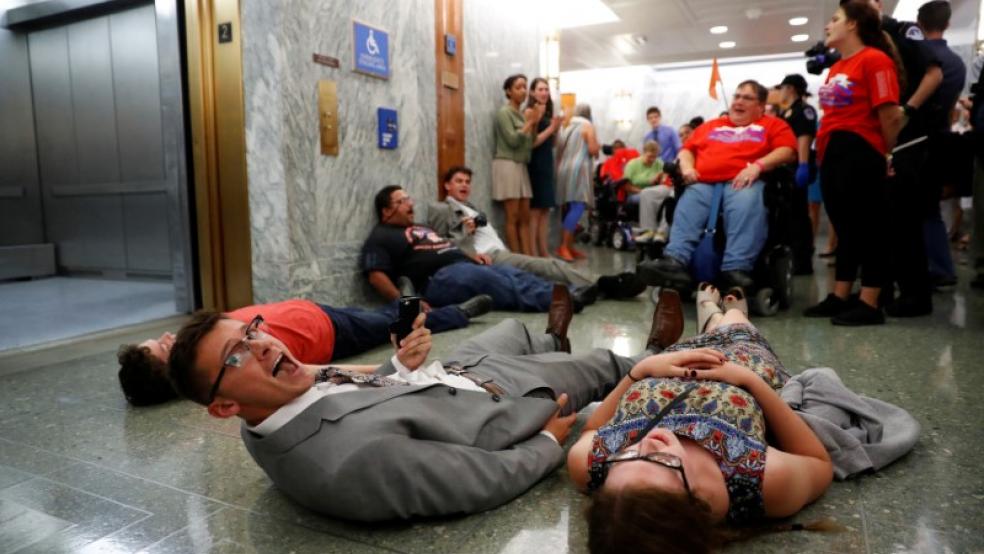CHICAGO (Reuters) - (The opinions expressed here are those of the author, a columnist for Reuters.)
The Republican proposals to repeal and replace the U.S. Affordable Care Act (ACA) would be a disaster for older Americans not yet on Medicare - but they also endanger Medicare itself.The Better Care Reconciliation Act (BCRA) under consideration in the U.S. Senate would mean higher premiums and reduced cost-sharing subsidies for lower-income older people. The Congressional Budget Office (CBO) has estimated, for example, that under this bill the annual premium for a 64-year-old person who earns $56,800 would skyrocket by $13,700. And the Medicaid cuts will put the squeeze on states’ ability to fund long-term care (http://reut.rs/2tfvvZt).Meanwhile, tax cuts for the wealthy contained in some of the Republican proposals would bring closer the projected insolvency date of the Medicare Part A trust fund, which pays for hospital, skilled nursing facility, home health and hospice benefits. Insolvency would require either a new revenue source or a reduction of healthcare services the program provides.The trustees of Medicare and Social Security released their respective annual reports on Thursday on the health of the programs. The news about the Part A trust fund was encouraging: the Medicare report said that lower-than-expected program spending in 2016 has pushed out the predicted date of insolvency for the Hospital Insurance Trust fund by one additional year, to 2029. But the Republican reform efforts could worsen that outlook. The American Health Care Act approved by the House of Representatives in March would repeal the Medicare payroll surtax on high-income workers, which was added under the ACA to shore up the hospital insurance trust fund. The first version of the BCRA also repealed the payroll surtax. On Thursday, however, Senate Republicans scrambling to save their struggling proposal unveiled a new version that would keep the tax - along with the net investment income tax. That tax imposes a 3.8 percent surtax on investment income for joint filers with more than $250,000 of adjusted gross income (AGI), and single filers with more than $200,000 of AGI. (Receipts from the investment tax go into the federal government’s general revenue coffers.)Both of these tax cuts could easily reappear as the horse trading continues. So it is worthwhile to consider how elimination of the payroll surcharge, in particular, could damage Medicare’s financial health.Medicare taps funding from several different sources. Part B (outpatient services) and Part D (prescription drugs) receive about three-quarters of their funding from general federal revenue, with the remainder coming from beneficiary premiums. Their financing is adequate into the indefinite future because the programs rely on these flexible revenue sources.Meanwhile, Part A is financed almost entirely by payroll taxes. Workers and employees each pay 1.45 percent of wages into the fund; the ACA increased the tax for taxpayers earning more than $200,000 (individual) and $250,000 (joint filers) by 0.9 percentage point. RISING COST PRESSUREMedicare faces rising enrollment - and financial pressure - due to the retirement of the baby boomer generation. The number of enrollees is projected to rise from 57 million in 2016 to nearly 90 million by 2040, according to the National Academy of Social Insurance (NASI). At the same time, the rising tide of boomer retirements means that the workforce paying Part A payroll taxes is growing more slowly.Rising healthcare costs also play an important role. The price of healthcare has been rising at about double the rate of general inflation.The solvency threat applies only to Part A, due to its reliance on the payroll tax. The trustees’ projected insolvency date has fluctuated a great deal over time; since 1970, it has been as close as two years away, and as distant as 28 years, according to NASI. Today’s projection is in the middle of those ranges.In 2009 - just before enactment of the ACA - the Medicare trustees forecast that insolvency was just eight years away. When the ACA passed, that number jumped to 19 years - due in part to the payroll tax surcharge but also reductions in payments to Medicare Advantage providers and to healthcare providers. Since then, the number has drawn somewhat closer.The ACA’s payroll surtax has provided a shot in the arm to the hospital insurance trust fund; repealing it would move up the projected insolvency date by a full two years, from 2028 to 2026, according to the CBO.The term “insolvency” does not mean bankruptcy for a government programme like Medicare. Instead, it would mean Medicare would have sufficient resources to pay only 88 percent of promised benefits. The shortfall would have to be closed by raising new revenue, slowing growth in spending, or both. And Republican leaders including House Speaker Paul Ryan routinely toss around insolvency as a justification for schemes to further privatize Medicare by sending seniors into an insurance marketplace with vouchers to buy coverage. “It’s an open question what would happen,” said Juliette Cubanski, associate director of the programme on Medicare policy at the Kaiser Family Foundation. “We’ve gotten close to it a couple times, but it’s never happened - and there is no statutory language governing a situation where the trust fund has no assets and insufficient funding to pay benefits. The spectre of it is daunting.” (Editing by Matthew Lewis)How Republican reform would weaken Medicare

Aaron Bernstein



